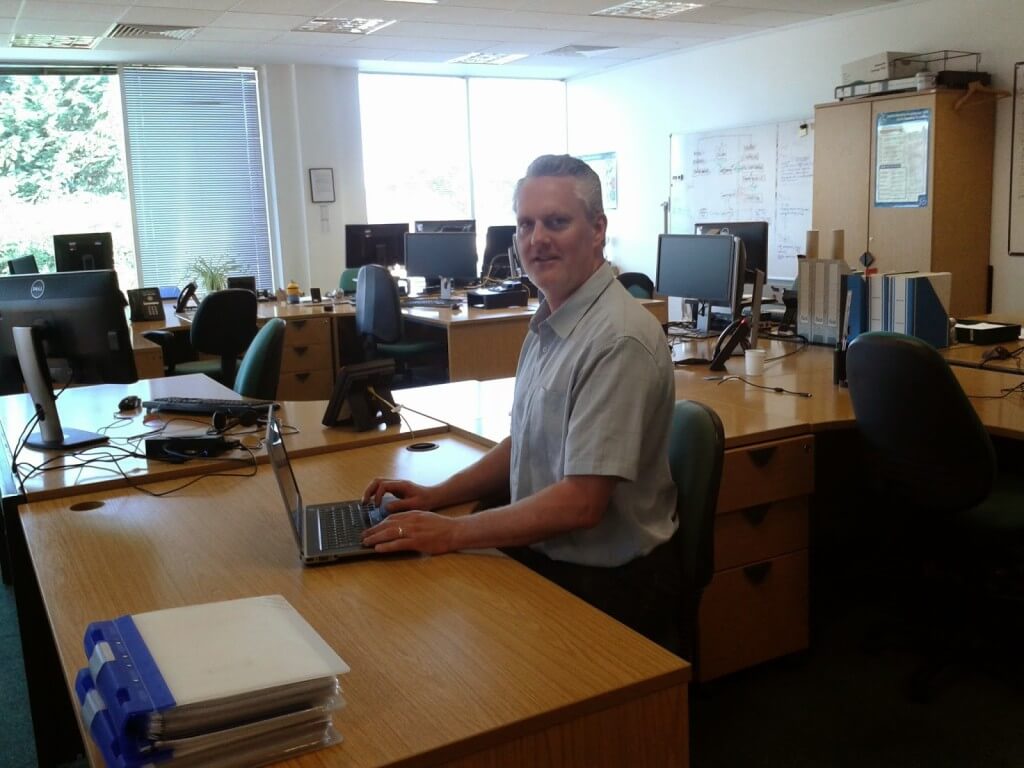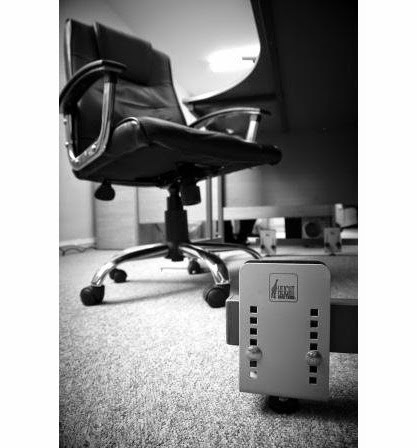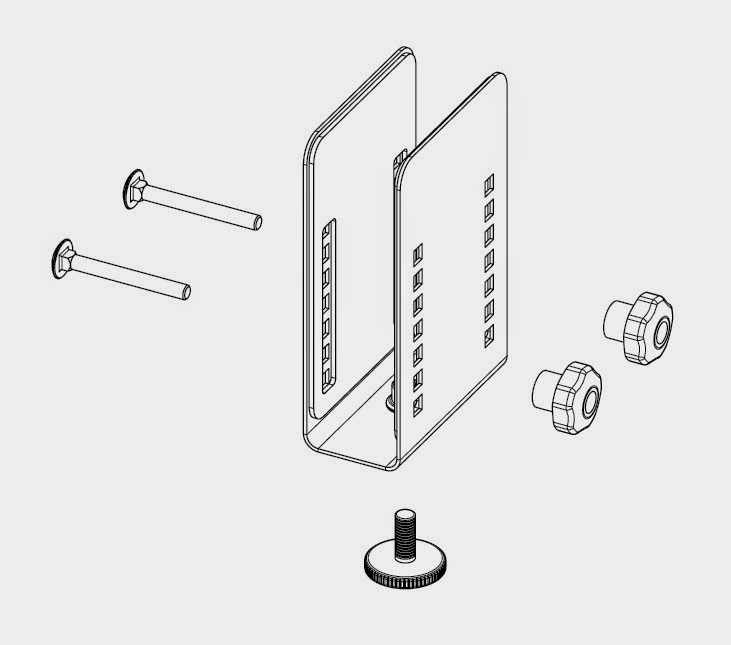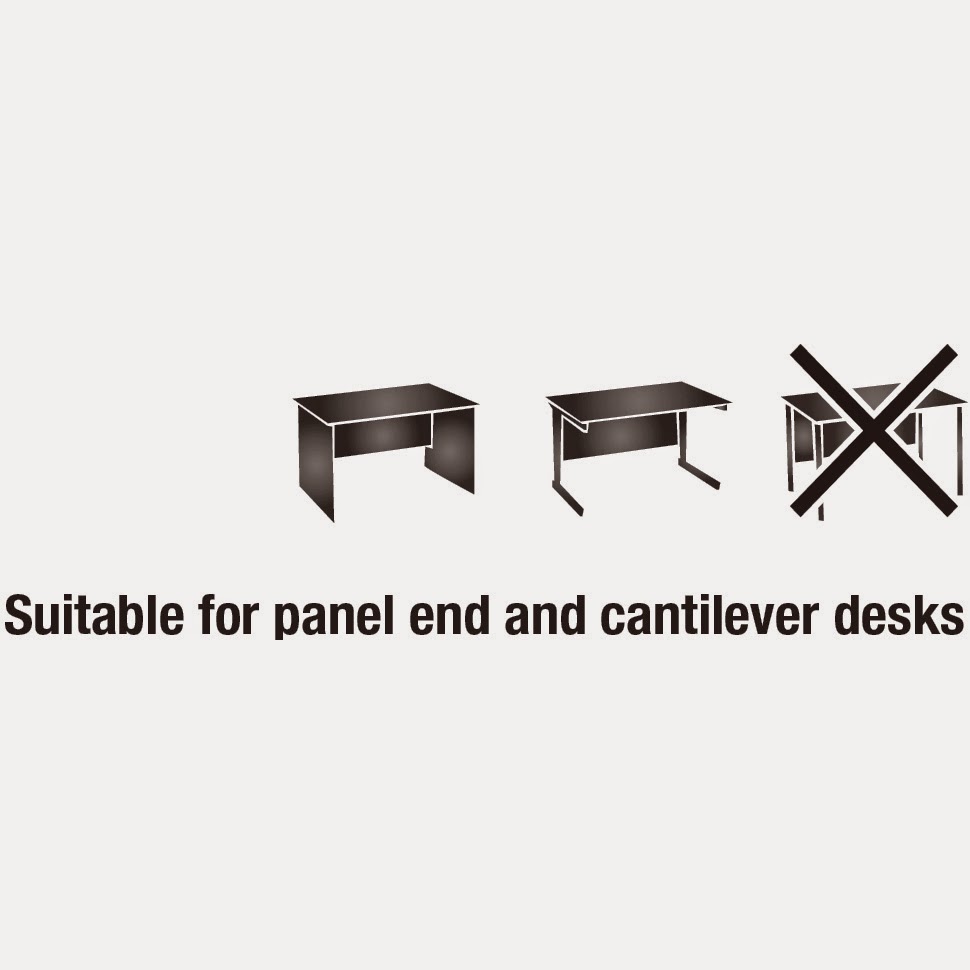Below is a guest post by Hadrian, an inventor in the UK. At 6’5″ tall, poor ergonomics contributed to his slipped disc which eventually required surgery. In order to cope with his recurring back pain, he had to adapt. In particular, he raised his work station. Unsatisfied with existing methods for raising desks, he invented a brilliant new desk raising device (see below image link). So without further ado, here is his story!
I have always enjoyed sports and been reasonably fit and healthy. I competed at high jump through my 20s and have done Martial Arts for most of my life. When I left school I worked in bars, night clubs, as a heavy goods driver and as an engineer before going to University in my mid-20s. Once I graduated I got my first office job which for the first time meant I was sitting down for most of the day. Up until then, although I had the occasional stiff back, I had never had any serious problems.
Around three years after leaving University I was getting more regular and increasingly debilitating episodes of back pain. These finally came to a head when going to Spain on holiday and over a period of about two days I went from being able to run seven miles in an hour to not being able to walk 100 meters. I got a flight home two weeks later but it was extremely uncomfortable and frightening; not just because it was Easy Jet and there wasn’t enough leg room. When I got back to the UK, medical investigations diagnosed a very serious prolapse of a disc (slipped disc) in my lower back.
Fortunately, I have private medical insurance and I was able to have the operation in a few weeks but unsurprisingly, my recovery was long and painful. I spent two days in hospital and even when I got home I had to spend most of my time lying down as sitting, standing and walking were uncomfortable. I had to do regular physiotherapy and take increasingly longer walks to try to build up my strength and stamina. One of the major problems with being incapacitated for even short periods of time is the degeneration of muscles and other soft tissues. What is worse is that in order to get to the disc the surgeons need to get past or through other structures. This inevitably means damage to surrounding tissue such as muscles, tendons and ligaments.
It took me three months before I was able to go back to work and even then I was not able to go back full time; I started with half days and built up to full time. I am lucky in that I have been able to get back to my Martial Arts but this took another six months and again I had to ease my way into this. Ten years on I still have to do physiotherapy and visit a chiropractor. Even with this I still get regular back problems and all I can do is to manage them as best I can. Fortunately, I have been able to avoid another serious set-back.
My employer at the time of my back operation did invest in a height adjustable desk on my return to work, though it wasn’t one of the very expensive ones where you press a button and it raises or lowers. It was one where you have to work out the height the desk needs to be at before assembling it. Once assembled it was very good but it took two guys around an hour to assemble it in the first place.
I moved jobs around six years ago and when I requested that my desk be raised as part of my work station assessment, my desk was put on blocks of wood. It struck me that this was not a very safe or ergonomic solution. It wasn’t even very cost affective, as the blocks had to be measured and cut to fit the desk. This is where I started to think there must be a better way.
Other than height adjustable desks, which are significantly more expensive than standard desks, all I was able to find were fairly crude blocks. These can only give you very rough adjustment. Also if you are very tall (6’2” and above) you need to stack up to three blocks on top of each other, which not only adds to the cost but also significantly increases the instability of the desk. There have been a number of reports of furniture falling off of these blocks.
As I have a background in engineering, I decided to design a better alternative and with the help of a small design company (Burrell Innovation), I believe we have come up with a revolutionary alternative to these blocks. The units are firmly attached to the desk so that they in affect become part of the desk, so there is no danger of them falling off and the desk can be moved with them in place. They allow for precise height adjustments from 35mm (1 ½ in) to 115mm (4 ½ in); this is 35mm or about 1 ½ inches higher than three stacked blocks. They have also been tested by TUV-SUD to withstand static loads of 230kg or 550lb. This is well in excess of maximum requirements for office desks of any major national or international trading standards.
Unfortunately, they do not work for all office desks but they do work for the majority of desks. They will not work with H leg desks and I do not advise that they are used with cantilever desks with round or oval legs as the desk raisers require a flat edge to grip the desk firmly. They will not work for desks that have built in units that go to the floor either.
Below are some recommendations for seated work. The desk raisers are helpful in achieving these.
- The seat back rest should be adjusted so you are sitting upright
- Good lumbar support should be achieved (i.e. the lower back should be supported)
- Seat height should be adjusted to achieve 4 – 7
- There should be no excess pressure on the underside of your thighs and back of the knees
- There should be room under the desk to allow changes in posture (no obstacles)
- Forearms should be horizontal and elbows approximately at right angles
- There should be minimal bending of the wrists and hands, they should be horizontal
- Screen should be at arm’s length and height and angle should be adjusted to allow a comfortable head position with the neck and head straight
- Ensure there is space in front of the keyboard to support your hands/wrists during pauses in keying. Place mouse close to keyboard
- A foot support can be provided if your feet do not now touch the ground once seated
- Armrests can be removed if requested via a Facilities Request
editor: Hadrian’s website is Height-Matters.Com. Thank you Hadrian for sharing your story! I hope others will share their tall related stories, no matter how long or short, similarly!







Brilliant, I just had the idea myself and am delighted someone else has already made it! Saves me time! Let’s see where I can order them!